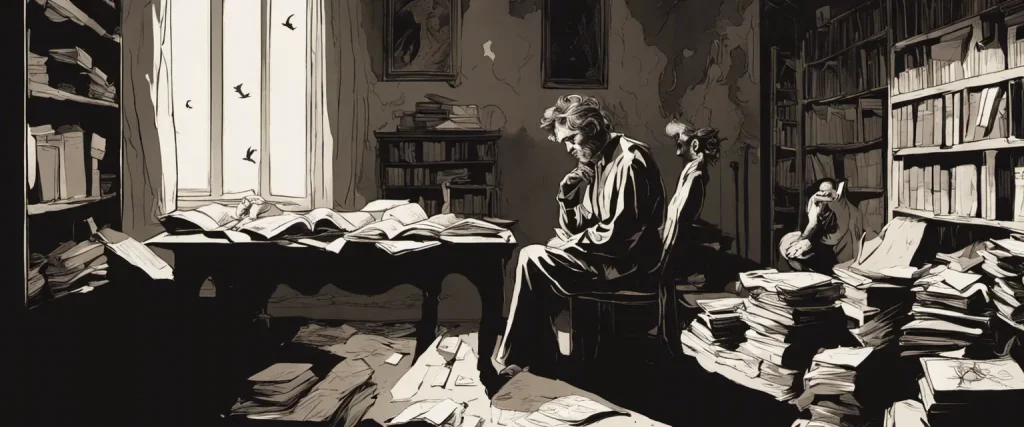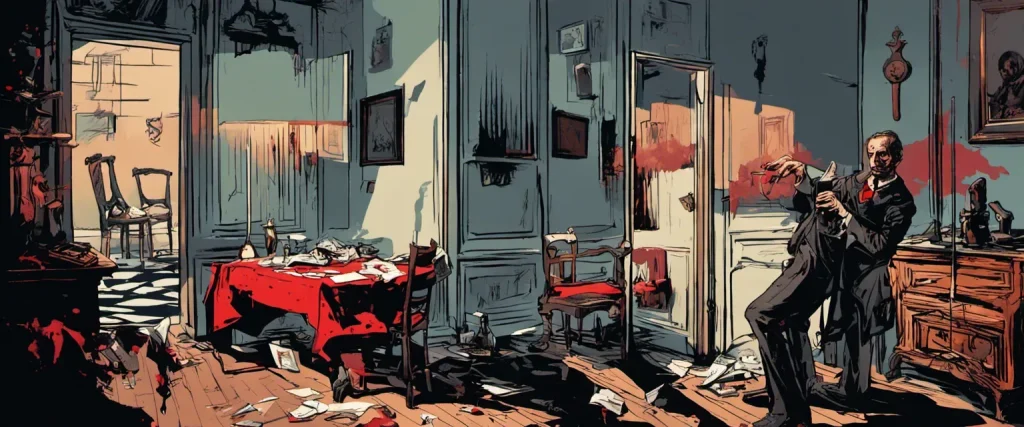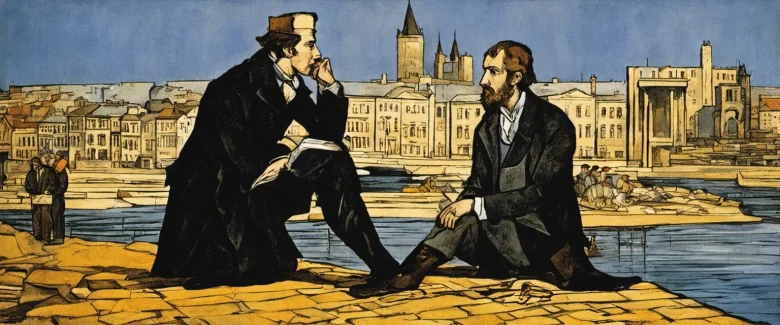In Fyodor Dostoevsky’s gripping masterpiece, Crime and Punishment, we are plunged into the depths of St. Petersburg’s dark underbelly, where one man’s tormented conscience drives him to commit a heinous crime. Set against the backdrop of 19th-century Russia, Dostoevsky delves into the complex themes of guilt, redemption, and the human condition. As one of the most influential authors in world literature, Fyodor Dostoevsky’s works continue to captivate readers with their psychological depth and profound exploration of moral dilemmas.
Chapter 1: Raskolnikov’s Inner Turmoil
Chapter 1: Raskolnikov’s Inner Turmoil begins by introducing the protagonist, Rodion Romanovich Raskolnikov, who lives in St. Petersburg. Raskolnikov, a highly intelligent and brooding former student, is depicted as a man grappling with inner turmoil and psychological distress. He has abandoned his studies and is living in poverty, surviving on money sent to him by his mother and sister.
Raskolnikov’s struggles primarily stem from his existential ponderings and his deep contemplation of his own worth and purpose. He believes that there are extraordinary individuals who are not bound by society’s moral standards and are thus superior and can transgress boundaries that common people cannot. This notion leads him to develop a theory, which he calls the “extraordinary man” theory, suggesting that certain exceptional individuals have the right to commit crimes for the greater good.
The chapter delves into Raskolnikov’s delusional behavior as he concocts a plan to test his theory. He reveals that he intends to murder a pawnbroker, Alyona Ivanovna, who he believes is corrupt and does more harm than good to society. Raskolnikov justifies this act as being within his rights as an extraordinary man who is willing to sacrifice one evil for the benefit of many.
Throughout the chapter, Raskolnikov’s thoughts and actions exhibit a complex mix of guilt, pride, fear, and defiance. He volunteers at a charity organization, exhibiting kindness and empathy towards others, yet his contemplations of murder reveal his deeply disturbed state of mind. This inner turmoil manifests itself in moments of delirium and intermittent nightmares.
As the chapter concludes, Raskolnikov’s plan is set in motion, leaving readers with a sense of anticipation and apprehension for what lies ahead.
Chapter 2: The Murder
Chapter 2 of Crime and Punishment by Fyodor Dostoevsky explores the journey of the protagonist, Rodion Raskolnikov, as he sets out to accomplish his plan of murdering Alyona Ivanovna, an old pawnbroker. The chapter begins with Raskolnikov, a destitute former university student, grappling with the concept of committing the crime. He convinces himself that the murder is justified because Alyona is a greedy and morally corrupt woman who preys on the vulnerable.
Raskolnikov meticulously prepares for the murder, procuring an old, blunt axe and crafting a strategy to ensure his actions remain undetected. Consumed by a mix of fear and determination, he visits Alyona Ivanovna’s apartment under the pretense of pawning his watch. However, once inside, his initial plan starts to unravel as unforeseen events unfold.
Alyona’s younger sister, Lizaveta, unexpectedly enters the apartment while Raskolnikov is searching for the old pawnbroker. Panicking, he hides in a separate room until an opportunity presents itself. When he finally confronts Alyona, his emotions overwhelm him, causing him to hesitate and lose his nerve momentarily.
Despite his internal struggle, Raskolnikov ultimately executes his plan. He viciously strikes Alyona with the axe, killing her instantly. However, when he attempts to flee the scene, Lizaveta appears, horrified by the sight of her sister’s lifeless body. Unable to control himself any longer, Raskolnikov turns the axe on her as well, leaving both women dead.
Chapter 2 offers insight into Raskolnikov’s inner turmoil, depicting the psychological toll the murder takes on him. It sets the stage for the moral and psychological ramifications that will haunt the protagonist throughout the rest of the novel.
Chapter 3: Investigation and Suspicion
Chapter 3: Investigation and Suspicion of the book Crime and Punishment by Fyodor Dostoevsky delves deeper into the aftermath of the murder committed by the protagonist, Rodion Raskolnikov. The chapter primarily focuses on the investigation carried out by the police and the rising suspicion surrounding Raskolnikov’s involvement in the crime.
The chapter begins with Raskolnikov waking up after his intense feverish state. He is initially oblivious to the fact that his landlady, Alyona Ivanovna, and her sister, Lizaveta, have been killed. However, as he becomes aware of his surroundings, he starts to recall bits and pieces of the horrific incident.
Meanwhile, the police have already begun their investigation. Petrovich, a police officer, visits Raskolnikov’s apartment and interrogates him about his whereabouts during the time of the murder. Raskolnikov skillfully lies and provides an alibi, asserting that he was home all evening. Although Petrovich seems skeptical, he does not have any concrete evidence to question Raskolnikov further.
As the investigation unfolds, Raskolnikov plunges into a state of paranoia and guilt. He becomes increasingly aware of the suspicions surrounding him, and this amplifies his sense of guilt, pushing him to question his own actions. The psychological tension within Raskolnikov continues to build, as he grapples with the repercussions of his crimes.
The chapter ends with Raskolnikov deciding to visit Sonya, a young prostitute, to seek solace and possibly confess his crimes. This decision marks a turning point in the novel, as Raskolnikov reaches a critical threshold in his inner struggle between morality and rationalization of his crime.
In summary, Chapter 3 of Crime and Punishment explores the investigation into the murder and the mounting suspicion surrounding Raskolnikov. It portrays his increasing psychological turmoil and guilt, ultimately leading him to seek absolution from Sonya.

Chapter 4: Psychological Turmoil
Chapter 4: Psychological Turmoil, in Fyodor Dostoevsky’s Crime and Punishment, delves into the inner turmoil and psychological state of the protagonist, Rodion Raskolnikov.
The chapter begins with Raskolnikov reflecting on his recent encounter with Marmeladov, a drunkard who shares his misery and despair. Despite initially being indifferent to Marmeladov’s afflictions, Raskolnikov cannot shake off the feeling of guilt that stems from his own misdeeds. As he wanders through the streets of St. Petersburg, his mind becomes consumed with thoughts of his imminent plan to murder the pawnbroker, Alyona Ivanovna.
Dostoevsky skillfully depicts Raskolnikov’s mental state through intense and vivid descriptions. The protagonist experiences a range of conflicting emotions, oscillating between complete apathy and intense anxiety. He envisions scenarios in which he could successfully execute the murder and rationalizes it as a necessary act for the greater good. However, bouts of panic and anxiety often overwhelm him, leaving him uncertain and contemplating the consequences of his plan.
Raskolnikov’s internal struggle is further explored as he meets several characters who challenge his moral justifications. Sonia, a young prostitute, becomes a symbol of redemption and a source of conflicting emotions for Raskolnikov. He desires her purity and innocence, yet feels unworthy and tainted by his own actions.
The chapter reaches its climax when Raskolnikov, plagued by his tormented conscience, decides to abandon his plan. However, before he can do so, he is unexpectedly confronted by Sergeyevich, an old acquaintance. The encounter stirs up Raskolnikov’s inner turmoil, leaving him feeling exposed and vulnerable.
In this chapter, Dostoevsky masterfully portrays Raskolnikov’s internal turmoil, showcasing his inner battle between his belief in his own superiority and the moral consequences of his actions. The psychological depth of the narrative contributes to the complexity and intrigue of Crime and Punishment as a novel.
Chapter 5: Redemption through Love
Chapter 5: Redemption Through Love in the book Crime and Punishment by Fyodor Dostoevsky delves into the protagonist Raskolnikov’s psychological transformation and his encounter with Sonja, a young prostitute. This chapter serves as a turning point in Raskolnikov’s journey toward redemption and explores the power of love and the possibility of redemption through human connection.
After committing the heinous act of murdering an old pawnbroker, Raskolnikov is plagued by guilt and inner turmoil. He isolates himself from society, sinking into a state of despair and nihilism. However, his encounter with Sonja changes the trajectory of his life. As fate brings them together, he discovers Sonja’s moral strength and purity in the face of her difficult circumstances.
Sonja, despite being trapped in the dismal world of prostitution, remains compassionate and selfless. Moved by her sincerity, Raskolnikov takes solace in her presence and finds himself awakening to feelings of empathy and compassion. Through their conversations, Raskolnikov grapples with his guilt, recognizing the consequences of his actions and the impact they have had on others.
Sonja becomes a source of moral guidance for Raskolnikov, as she introduces him to the concept of divine love and forgiveness. Through her unwavering faith and dedication to helping others, she embodies the transformative power of empathy and compassion. Sonja’s love challenges Raskolnikov’s nihilistic beliefs, and he starts contemplating the possibility of redemption, believing that love can save him from the abyss of his guilt and wrongdoing.
In this chapter, Dostoevsky explores the idea that redemption is attainable through genuine human connection and love. Raskolnikov gradually realizes that his path to redemption lies in acknowledging his guilt, accepting his responsibility, and seeking forgiveness. Sonja serves as a catalyst for this transformation, illuminating the profound effect that love and compassion can have on the human soul.
Chapter 6: The Trial
Chapter 6 of Fyodor Dostoevsky’s Crime and Punishment centers around the trial of the main character, Raskolnikov. The chapter begins with Raskolnikov attending his first formal hearing at the courthouse. Raskolnikov finds himself overwhelmed by the chaotic and tense atmosphere. The courtroom is filled with tension as several witnesses testify against him.
The first witness is Alyona Ivanovna’s sister, Lizaveta, who had inadvertently stumbled upon Raskolnikov during the murder. Her testimony confirms his presence at the crime scene and raises doubts about his motives. The subsequent testimonies of the painters who discovered the murder, the porter, and the pawnbroker’s assistant further incriminate Raskolnikov and solidify his connection to the crime.
Throughout the proceedings, Raskolnikov’s mental state deteriorates. He feels increasingly cornered and paranoid as he watches his guilt being unravelled in front of the court. He is tormented by his internal struggles, vacillating between arrogance and fear.
As the trial progresses, Raskolnikov becomes aware of the mounting evidence against him. The public prosecutor presents his case, outlining all the incriminating details and motives that involve Raskolnikov. The defense attorney appears weak and unsuccessful in presenting a convincing argument to counter the prosecutor’s claims.
As the chapter concludes, Raskolnikov is left in a state of despair and hopelessness. He realizes that he is facing an uphill battle to prove his innocence, and the weight of his crime becomes increasingly difficult for him to bear.

Chapter 7: Confronting the Truth
Chapter 7 of Crime and Punishment by Fyodor Dostoevsky is a pivotal moment in the novel as it delves into the protagonist’s, Raskolnikov, inner struggles and his confrontation with truth.
The chapter begins with Raskolnikov returning to his shabby room after fainting at the police station. He is in a state of confusion, partially due to his guilt over the murder he committed and partly because of his deteriorating mental state. Raskolnikov is haunted by the crime and overwhelmed by his inner conflict.
Amidst this turmoil, Raskolnikov receives an unexpected visitor, Razumikhin. Razumikhin is Raskolnikov’s friend, and his unwavering support helps Raskolnikov to regain some semblance of stability. In their conversation, Raskolnikov reveals parts of his disturbing theory wherein extraordinary individuals are capable of committing crimes without punishment. However, as he explains his theory, he becomes aware of the fallacy in his logic and starts to question the validity of his beliefs.
As the chapter progresses, Raskolnikov begins to realize the weight of his crime, both in terms of his personal struggle and the societal consequences. He feels an increasing sense of paranoia and anxiety, evident in his decision to burn his belongings, including all evidence that could incriminate him. This act symbolizes his attempt to erase any connection to the crime and highlights his growing desperation.
In this chapter, Raskolnikov is confronted with the harsh reality of his actions and the moral implications they carry. His encounter with Razumikhin and introspection slowly chip away at his distorted beliefs. Raskolnikov’s realization of the truth heightens the tension within, leaving the reader eagerly anticipating the resolution of his internal conflicts and the consequences he will have to face.
Chapter 8: Redemption and Rebirth
In Chapter 8 of the novel Crime and Punishment by Fyodor Dostoevsky, the theme of redemption and rebirth takes center stage as the protagonist, Raskolnikov, continues to grapple with the guilt and turmoil of his heinous crime. The chapter opens with Raskolnikov awakening from a feverish dream, symbolizing his internal struggle and the state of his conscience. He realizes that he can no longer escape the consequences of his actions and is consumed by intense remorse and self-hatred.
Raskolnikov’s sister, Dunya, arrives accompanied by her fiancé, Luzhin, a wealthy and self-centered man. Dunya’s purpose is to convince Raskolnikov to accept Luzhin’s marriage proposal, as his financial support would greatly benefit the family. However, Raskolnikov senses something sinister behind Luzhin’s intentions and refuses to consent to the marriage.
As the chapter progresses, Raskolnikov encounters Sonya, a young prostitute forced into the trade by poverty. Sonya, known for her unwavering faith and purity of heart, becomes a catalyst for Raskolnikov’s redemption. In their conversation, Sonya reveals her tragic background and expresses her belief that everyone can be saved through suffering and penance. Inspired by her words and recognizing her genuine compassion for others, Raskolnikov is moved to tears and feels a strong connection to her.
The chapter ends with Raskolnikov making a pivotal decision – he decides to confess his crime to the authorities. This moment signifies the rebirth of his conscience and the beginning of his path towards atonement. Raskolnikov realizes that he cannot find peace until he takes responsibility for his actions and accepts the consequences. This act of redemption and the potential for rebirth will provide the foundation for Raskolnikov’s transformation and further exploration of his character throughout the rest of the novel.
After Reading
In conclusion, Crime and Punishment by Fyodor Dostoevsky is a powerful exploration of the human psyche and the consequences of criminal actions. The novel follows the story of Raskolnikov, a troubled and impoverished former student, as he wrestles with his guilt after committing a brutal murder. Through this gripping narrative, Dostoevsky delves into the themes of morality, redemption, and the complexities of the human condition. As Raskolnikov grapples with his own conscience and the effects of his crime on those around him, the author forces readers to confront their own notions of right and wrong. Ultimately, the novel presents a thought-provoking and provocative examination of the nature of guilt and punishment, leaving readers both shaken and introspective long after turning the final page.
More Classic Noverls:
1. Oliver Twist” by Charles Dickens:
A timeless classic, “Oliver Twist” takes readers on a journey through the gritty streets of 19th-century London. It tells the story of young Oliver, who faces great adversity and hardship but manages to retain his innate goodness and resilience. Dickens expertly depicts the social inequalities of Victorian society while exploring themes of injustice, compassion, and the power of hope. From its vivid characters to its gripping plot, “Oliver Twist” is a must-read for anyone seeking a captivating tale of survival and redemption.
2. The Red and the Black” by Stendhal:
Set in 19th-century France, “The Red and the Black” offers a penetrating exploration of ambition, love, and hypocrisy. It follows the life of Julien Sorel, a young man from a humble background, as he climbs the social ladder through his wit, intelligence, and ruthless determination. Stendhal’s masterful characterizations and incisive critique of societal norms make this novel a thought-provoking examination of human nature. Filled with political intrigue, romantic entanglements, and moral dilemmas, “The Red and the Black” remains a brilliant portrayal of an ambitious young man’s quest for success.
3. Madame Bovary” by Gustave Flaubert:
Considered a cornerstone of literary realism, “Madame Bovary” paints a vivid portrait of Emma Bovary, a young woman trapped in the stifling provincial life of 19th-century France. Seeking fulfillment in passionate love affairs and material possessions, Emma spirals into a world of disillusionment and despair. Flaubert’s lyrical prose and detailed descriptions create an immersive reading experience, while his exploration of female desire and societal expectations remains highly relevant. “Madame Bovary” is both a beautifully crafted novel and a critique of the constraints placed on women in a patriarchal society.
4. Pride and Prejudice” by Jane Austen:
A delightful blend of romance, wit, and social commentary, “Pride and Prejudice” is a beloved classic that still captures readers’ hearts to this day. Jane Austen’s remarkable novel introduces us to the quick-witted and spirited Elizabeth Bennet, whose initial disdain for the proud Mr. Darcy evolves into a complex relationship filled with misunderstandings and personal growth. Through her astute observations of 19th-century English society, Austen beautifully depicts the limitations placed on women and the importance of overcoming prejudices. With its engaging characters and sparkling dialogue, “Pride and Prejudice” is a timeless tale of love, self-discovery, and societal expectations.
5. “To Kill a Mockingbird” by Harper Lee:
An American literary classic, “To Kill a Mockingbird” tackles profound themes of racism, injustice, and the loss of innocence. Set in the racially charged 1930s in Alabama, the story is narrated through the eyes of Scout Finch, a young girl, as she grapples with the complexities of her small town and the trial of a black man accused of rape. Harper Lee’s powerful storytelling and vividly drawn characters, such as the heroic Atticus Finch, make this novel an unforgettable exploration of moral courage, empathy, and the fight against prejudice. “To Kill a Mockingbird” continues to resonate today as a timeless reminder of the importance of compassion and standing up for what is right.



